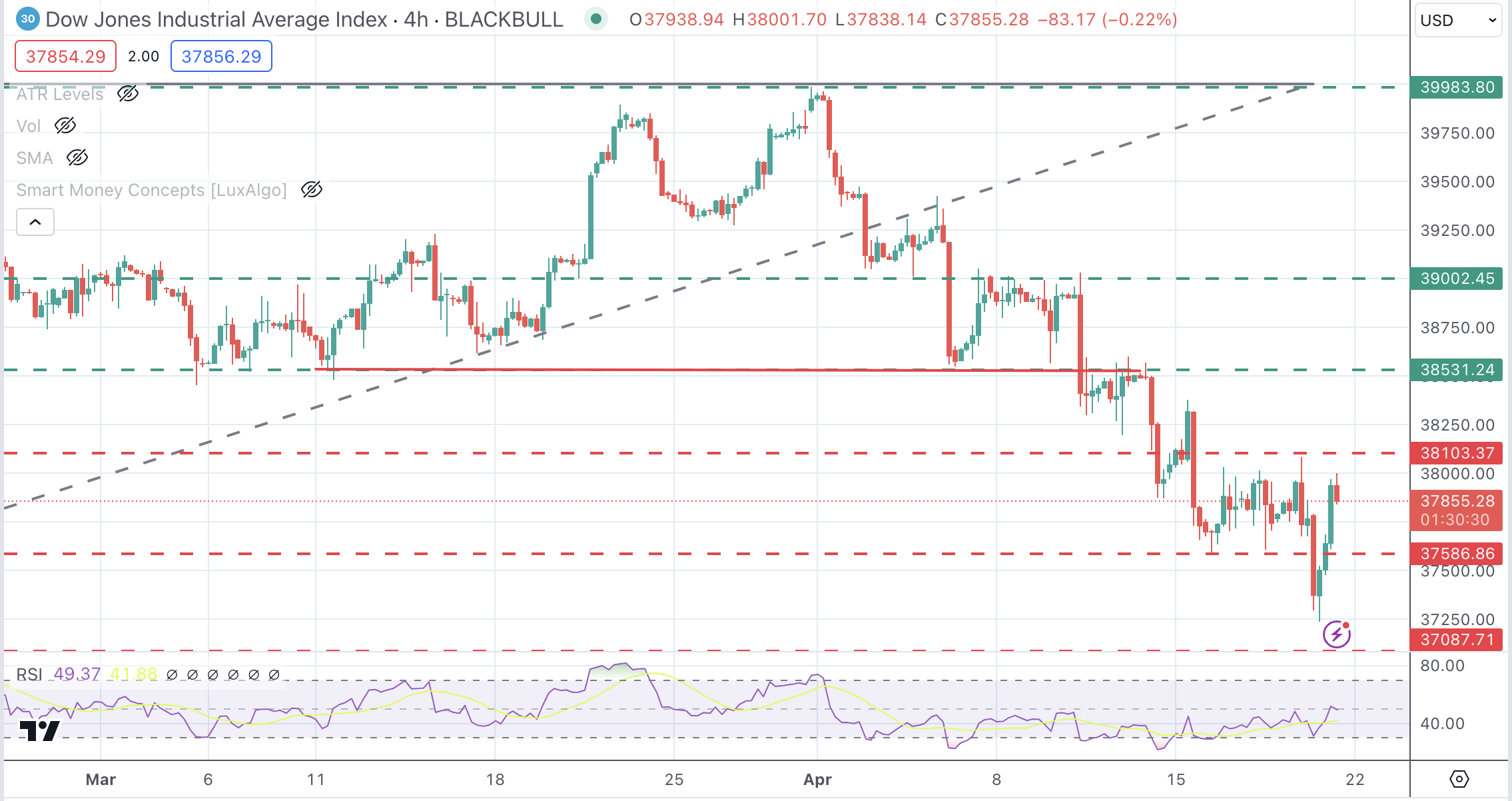- Dow Jones gains on the back of bright earnings data from American Express.
- Geopolitical concerns have eased, but investors remain wary of risk.
- Dow Jones trend needs to break resistances at 38,105 and 38,531 to cancel the bearish bias.
The Dow Jones Industrial Average (DJIA) is trading moderately higher on Friday with Wall Street indexes mixed on looming geopolitical concerns. American Express has shown better-than-expected revenue, net income, and EPS numbers boosting its yearly growth prospects and pushing the whole index higher
News from an Israeli attack on Iran rattled markets earlier on Friday, although the Islamic Republic has downplayed the incident and showed no intention to retaliate.
The US economic calendar is light today. Chicago Federal Reserve President Austan Goolsbee reiterated the lack of progress on inflation but showed confidence that core inflation will return to the 2% level.
The Dow Jones irises 0.6% to 38,007, while the S&P 500 drops 0.45% to 4,987 and the NASDAQ dives 1.38% to 15,386.
Dow Jones news
A majority of the Wall Street sectors are posting gains with Energy stocks leading gains thanks to a 1.2% advance, followed by Utilities, up 1.2%. On the negative side, Communication Services drops 1.6%, and Technology is down 1.4%.
American Express (AXP) rallies 5.5% to $229.37. Next is United Health Group (UNH) with a 2.7% gain to $506.21. On the losing end, Amazon (AMZN) drops 2.1% to $175.47, and Apple (AAPL) loses 1.1% to $165,06.
Dow Jones technical outlook
The DJIA is trimming some losses on Friday, although the broader bearish trend from March highs near 40,000 remains intact. The resistance area at 38,103 should be breached to ease downside pressure and clear the path toward 38,530.
On the downside, the support level at 37,087 is the 38.2% Fibonacci retracement of the November-March rally and a previous support area. This might be a tough nut to crack for sellers. Below here, the target is 36,545.
Dow Jones Index 4-Hour Chart

Dow Jones FAQs
The Dow Jones Industrial Average, one of the oldest stock market indices in the world, is compiled of the 30 most traded stocks in the US. The index is price-weighted rather than weighted by capitalization. It is calculated by summing the prices of the constituent stocks and dividing them by a factor, currently 0.152. The index was founded by Charles Dow, who also founded the Wall Street Journal. In later years it has been criticized for not being broadly representative enough because it only tracks 30 conglomerates, unlike broader indices such as the S&P 500.
Many different factors drive the Dow Jones Industrial Average (DJIA). The aggregate performance of the component companies revealed in quarterly company earnings reports is the main one. US and global macroeconomic data also contributes as it impacts on investor sentiment. The level of interest rates, set by the Federal Reserve (Fed), also influences the DJIA as it affects the cost of credit, on which many corporations are heavily reliant. Therefore, inflation can be a major driver as well as other metrics which impact the Fed decisions.
Dow Theory is a method for identifying the primary trend of the stock market developed by Charles Dow. A key step is to compare the direction of the Dow Jones Industrial Average (DJIA) and the Dow Jones Transportation Average (DJTA) and only follow trends where both are moving in the same direction. Volume is a confirmatory criteria. The theory uses elements of peak and trough analysis. Dow’s theory posits three trend phases: accumulation, when smart money starts buying or selling; public participation, when the wider public joins in; and distribution, when the smart money exits.
There are a number of ways to trade the DJIA. One is to use ETFs which allow investors to trade the DJIA as a single security, rather than having to buy shares in all 30 constituent companies. A leading example is the SPDR Dow Jones Industrial Average ETF (DIA). DJIA futures contracts enable traders to speculate on the future value of the index and Options provide the right, but not the obligation, to buy or sell the index at a predetermined price in the future. Mutual funds enable investors to buy a share of a diversified portfolio of DJIA stocks thus providing exposure to the overall index.
Information on these pages contains forward-looking statements that involve risks and uncertainties. Markets and instruments profiled on this page are for informational purposes only and should not in any way come across as a recommendation to buy or sell in these assets. You should do your own thorough research before making any investment decisions. FXStreet does not in any way guarantee that this information is free from mistakes, errors, or material misstatements. It also does not guarantee that this information is of a timely nature. Investing in Open Markets involves a great deal of risk, including the loss of all or a portion of your investment, as well as emotional distress. All risks, losses and costs associated with investing, including total loss of principal, are your responsibility. The views and opinions expressed in this article are those of the authors and do not necessarily reflect the official policy or position of FXStreet nor its advertisers. The author will not be held responsible for information that is found at the end of links posted on this page.
If not otherwise explicitly mentioned in the body of the article, at the time of writing, the author has no position in any stock mentioned in this article and no business relationship with any company mentioned. The author has not received compensation for writing this article, other than from FXStreet.
FXStreet and the author do not provide personalized recommendations. The author makes no representations as to the accuracy, completeness, or suitability of this information. FXStreet and the author will not be liable for any errors, omissions or any losses, injuries or damages arising from this information and its display or use. Errors and omissions excepted.
The author and FXStreet are not registered investment advisors and nothing in this article is intended to be investment advice.
Recommended content
Editors’ Picks

Gold breaks through $3,450, fresh record highs
Gold price continues to build on its record rally, hitting another all-time high above $3,450 in Asian trading on Tuesday. Investors continue to flock to safety in the traditional store of value, the Gold price, amidst heightened risks of a US recession and financial market instability.

AUD/USD holds steady above 0.6400 amid a tepid US Dollar bounce
AUD/USD consolidates above 0.6400 in the Asian session on Tuesday. The US Dollar attempts a tepid bounce amid the uncertainty over Trump's trade policies and the weakening confidence in the US economy. Concerns about the rapidly escalating US-China trade war act as a headwind for the Aussie.

USD/JPY mires in multi-month low near 140.50
USD/JPY stays defensive near 140.50 in the Asian session on Tuesday, consolidating Monday's downfall to seven-month lows. Trade war concerns, global recession fears, hopes for a US-Japan trade deal, and the divergent BoJ-Fed bets could continue to underpin the Japanese Yen despite a broad US Dollar rebound.

ARK Invest integrates Canada's 3iQ Solana Staking ETF into its crypto funds
Asset manager ARK Invest announced on Monday that it added exposure for Solana staking to its ARK Next Generation Internet exchange-traded fund and ARK Fintech Innovation ETF through an investment in Canada's 3iQ Solana Staking ETF.

Five fundamentals for the week: Traders confront the trade war, important surveys, key Fed speech Premium
Will the US strike a trade deal with Japan? That would be positive progress. However, recent developments are not that positive, and there's only one certainty: headlines will dominate markets. Fresh US economic data is also of interest.

The Best brokers to trade EUR/USD
SPONSORED Discover the top brokers for trading EUR/USD in 2025. Our list features brokers with competitive spreads, fast execution, and powerful platforms. Whether you're a beginner or an expert, find the right partner to navigate the dynamic Forex market.



